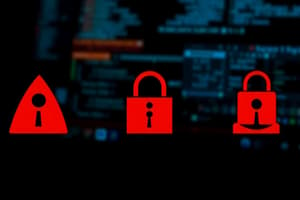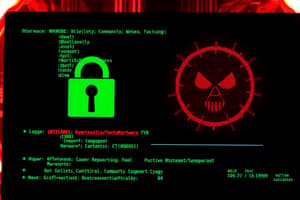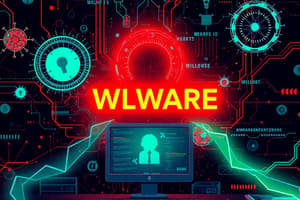Podcast
Questions and Answers
What differentiates worms from viruses in their method of spreading?
What differentiates worms from viruses in their method of spreading?
- Worms require user action to spread.
- Viruses can spread automatically through networks.
- Worms spread without user action. (correct)
- Viruses are designed to overload systems.
How does a Trojan horse typically reach a user's computer?
How does a Trojan horse typically reach a user's computer?
- It is sent as a system update.
- It is often disguised as legitimate software. (correct)
- It is automatically installed by the operating system.
- It can install itself without any user action.
Which of the following is a direct consequence of executing a Trojan horse?
Which of the following is a direct consequence of executing a Trojan horse?
- Access granted to cyber criminals. (correct)
- Automatic uninstalling of genuine software.
- Immediate data backup of personal information.
- Enhanced security features added to the system.
What type of software is often bundled with Trojan horses that poses a risk to users?
What type of software is often bundled with Trojan horses that poses a risk to users?
Why are worms considered more dangerous than viruses?
Why are worms considered more dangerous than viruses?
What is a characteristic feature of spyware that might be installed via Trojan horses?
What is a characteristic feature of spyware that might be installed via Trojan horses?
What important step should be taken to mitigate the risks of worms and other malware?
What important step should be taken to mitigate the risks of worms and other malware?
What aspect of a virus makes it different from a worm?
What aspect of a virus makes it different from a worm?
What is the primary purpose of the email in question?
What is the primary purpose of the email in question?
What is a common mistake found in the email regarding verb usage?
What is a common mistake found in the email regarding verb usage?
Which of the following characteristics indicates that the email is likely a phishing attempt?
Which of the following characteristics indicates that the email is likely a phishing attempt?
What grammatical error is prevalent in the sentence 'an unauthorized user might be trying to access your accounts'?
What grammatical error is prevalent in the sentence 'an unauthorized user might be trying to access your accounts'?
What is one potential risk of clicking the 'LOG IN HERE' link in the email?
What is one potential risk of clicking the 'LOG IN HERE' link in the email?
What is the mistake related to possessive usage in the email?
What is the mistake related to possessive usage in the email?
Which of the following is a sign that the email is not from a legitimate source?
Which of the following is a sign that the email is not from a legitimate source?
What could be a misleading feature of the email that might confuse the recipient?
What could be a misleading feature of the email that might confuse the recipient?
What is the primary function of ransomware?
What is the primary function of ransomware?
Which type of malware is designed to deceive users by appearing as legitimate software?
Which type of malware is designed to deceive users by appearing as legitimate software?
What method is most effective for preventing damage caused by malware once executed?
What method is most effective for preventing damage caused by malware once executed?
Which type of malware specifically collects user information by monitoring actions on a computer?
Which type of malware specifically collects user information by monitoring actions on a computer?
How do worms differ from viruses?
How do worms differ from viruses?
What is the main purpose of adware?
What is the main purpose of adware?
What critical action should users take to minimize the risk of falling victim to phishing attacks?
What critical action should users take to minimize the risk of falling victim to phishing attacks?
Which characteristic is NOT associated with Trojan horses?
Which characteristic is NOT associated with Trojan horses?
What is a common consequence of a malware infection once executed?
What is a common consequence of a malware infection once executed?
What is one function of a firewall in relation to incoming and outgoing data?
What is one function of a firewall in relation to incoming and outgoing data?
How does a firewall respond when data fails to meet the set criteria?
How does a firewall respond when data fails to meet the set criteria?
Which feature allows a firewall to prevent access to unwanted websites?
Which feature allows a firewall to prevent access to unwanted websites?
In what way can a firewall assist in maintaining security against internal threats?
In what way can a firewall assist in maintaining security against internal threats?
What type of network does a firewall commonly protect?
What type of network does a firewall commonly protect?
What can a firewall do if it identifies a potential security issue?
What can a firewall do if it identifies a potential security issue?
Why is logging incoming and outgoing traffic useful for a firewall?
Why is logging incoming and outgoing traffic useful for a firewall?
Which of the following statements about firewalls is true?
Which of the following statements about firewalls is true?
What is scareware primarily designed to exploit?
What is scareware primarily designed to exploit?
Which method involves tricking a user into downloading malware by pretending to be a reputable company?
Which method involves tricking a user into downloading malware by pretending to be a reputable company?
What tactic is commonly used in baiting attacks?
What tactic is commonly used in baiting attacks?
Which of the following is NOT a type of social engineering threat mentioned?
Which of the following is NOT a type of social engineering threat mentioned?
What does the baiting technique rely on from the user?
What does the baiting technique rely on from the user?
What does the strategy used in phishing rely on?
What does the strategy used in phishing rely on?
In which scenario would a cybercriminal pretend to be an IT professional?
In which scenario would a cybercriminal pretend to be an IT professional?
What characteristic of a scareware pop-up message makes it effective?
What characteristic of a scareware pop-up message makes it effective?
Which type of attack might lead to a user unintentionally downloading harmful software?
Which type of attack might lead to a user unintentionally downloading harmful software?
What is a key psychological factor exploited by phone call scams?
What is a key psychological factor exploited by phone call scams?
Flashcards are hidden until you start studying
Study Notes
Malware
- Malware is a type of software that can damage computer systems.
- Malware is often spread via email attachments, infected websites, or malicious links embedded in instant messages.
- Malware can be used for various malicious activities, including stealing personal information, encrypting data, or causing system crashes.
Types of Malware
- Viruses: Programs or code that can replicate themselves and cause damage to files or the computer system. They require an active host program or an infected operating system to run.
- Worms: Standalone viruses that can self-replicate and spread to other computers, typically through networks by targeting computers with weak security. Examples include the 'I Love You' worm.
- Trojan Horses: Malicious programs disguised as legitimate software that can replace or modify legitimate software to cause harm. They need to be executed by the user and often arrive as email attachments or are downloaded from infected websites.
- Spyware: Software that gathers information by monitoring user activity on their computer, such as keystrokes, to send to the attacker.
- Adware: Software that generates unwanted advertisements on a user's computer, often in the form of pop-ups or browser redirects.
- Ransomware: Programs that encrypt data on a user's computer and demand payment (ransom) for decryption. They are often spread through Trojan horses or social engineering.
Social Engineering
- Social engineering is a tactic used by cybercriminals to manipulate users into giving up personal information or granting access to their computer systems.
- Examples of social engineering techniques include:
- Baiting: Leaving malware-infected memory sticks in public places for unsuspecting users to find.
- Phishing: Sending legitimate-looking emails containing malicious links to redirect users to fake websites.
- Scareware: Using pop-up messages to scare users into downloading fake anti-virus software.
- Phone Calls: Using fake IT professionals to trick users into downloading software that gives the attacker access to their device.
Protecting Against Malware
- Employing strong passwords and keeping software up to date are essential for preventing malware infections.
- Using anti-virus software and firewalls can help protect computers from malware attacks.
- Avoiding suspicious emails and links and exercising caution when downloading files can help mitigate the risk of malware infections.
- Regular backups of important files can help mitigate the impact of ransomware attacks.
Firewalls
- Firewalls can help protect computers from malware and hackers by examining network traffic between a computer or internal network and a public network like the internet.
- They check if incoming or outgoing data meets predefined security criteria and block traffic that fails to meet those criteria.
- They can be used to log network activity and identify potential security issues.
- Firewalls can prevent access to undesirable websites and can be configured to block specific IP addresses.
- They can help prevent the spread of malware by blocking communication with known malware sources.
- Firewalls can alert users when software tries to access external data sources, allowing users to control data access.
Studying That Suits You
Use AI to generate personalized quizzes and flashcards to suit your learning preferences.



